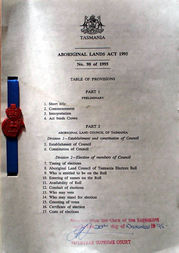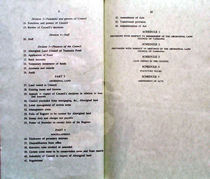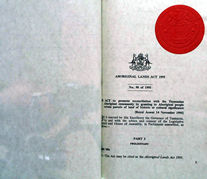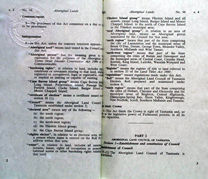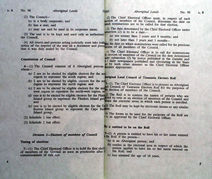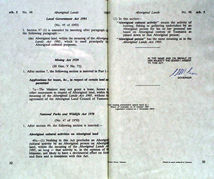

Aboriginal Lands Act 1995 (Tas)
Significance
This law acknowledges the dispossession of Tasmania's Indigenous people and recognises certain rights of Tasmanians of Aboriginal descent. It is the first such legislation in Tasmania, where the assumption that no Aboriginal people remained after the first 50 years of the Colony meant the issue of reconciliation in law was ignored.The Act provides for the establishment of an elected Aboriginal Land Council to own and manage lands of historical and cultural significance.
History
The Colonial Office Instructions to Lieutenant-Governor Collins were to 'open intercourse with the natives, and to conciliate their goodwill'. Beyond that the question of civil and property rights of the Aboriginal inhabitants was rarely raised by early Tasmanian governors. It was sometimes assumed that Aboriginal people were British subjects, but this was rarely asserted so as to confer on Aboriginal people rights enforceable at law.George Arthur, who governed Tasmania from 1824 to 1837, considered a form of negotiation with Tasmanian Aborigines, but he did not question British sovereignty either in practice or in theory. His Proclamation, published on 19 April 1828 in the Hobart Town Gazette thus states on the one hand that 'humanity and natural equity, equally enforce the duty of protecting and civilising the Aboriginal inhabitants', and on the other, that 'the Aborigines wander over extensive tracts of Country, without cultivating, or permanently occupying any portion of it'.
This Proclamation announced a dual policy of legislating to 'restrict the intercourse between the White and Coloured inhabitants' and negotiating 'with certain Chiefs of Aboriginal Tribes'. Arthur's viewpoint thus reflected and expressed the doctrine of terra nullius or 'no man's land', a concept derived from the 17th century sources of international law. The implication of Arthur's policy was that the Aboriginal occupants of the Island had rights as human beings, but lacked sovereignty and thus constitutional existence.
This Proclamation was issued at a time of frequent violence between Aboriginal and European people in country districts. Although Aboriginal numbers were by then reduced to a few hundred, there was serious doubt in Arthur's mind whether European inland occupation was viable. In September 1828 Arthur declared martial law in these districts. In this situation British law, criminal and martial, and the associated instruments of executive power, were only marginally effective. The hopeful Proclamation of April 1828, and the despairing declaration of martial law a few months later reveal the contradictory policies under which Arthur hoped that bloodshed would be checked 'as much as possible'.
In 1832, after remaining Aboriginal people had been removed to Flinders Island, Arthur ruminated:
It was a fatal error in the first settlement of Van Diemen's Land that a treaty was not entered into with the Natives, of which Savages well comprehend the nature – had they received some compensation for the territory they surrendered, no matter how trifling, and had adequate laws been from the very first introduced and enforced for their protection, His Majesty's Government would have acquired a valuable possession without the injurious consequences which have followed our occupation and which must ever remain a stain upon the Colonisation of Van Diemen's land [italics added].The removal of the Tasmanian Aborigines to Flinders Island continued only to 1847. In 1846 the Aborigines on the island, fearing the return of an unpopular former Superintendent, Dr Henry Jeanneret, took the unprecedented step of petitioning Queen Victoria. The Medical Superintendent on Flinders Island, Dr Joseph Milligan, forwarded this petition, saying that it was 'almost the first evidence of appreciation of the value of civilised institutions and government'. To historian Henry Reynolds this petition embodies 'the most important Aboriginal historical interpretation for the colonial period anywhere in Australia'.
According to an account Milligan forwarded to the Colonial Secretary of Van Diemen's Land, the petition had been initiated by the Aborigines themselves. Milligan wrote that 'the Blackmen' had sought the assistance of Robert Clark, the Catechist on the island, to compose the petition. Milligan authorised Clark do so, desiring that as nearly as he possibly could, Clark 'embody their own express ideas in fit words for the occasion'. The Colonial Secretary and Lieutenant-Governor Eardley-Wilmot supported the steps to forward the petition. Eventually the Queen, in the words of Earl Grey, the British Colonial Secretary, received the petition 'very graciously'.
The subject of most of the petition was the alleged bad conduct of Dr Jeanneret, but the opening statements are much broader:
The humble petition of the free Aboriginal Inhabitants of V. D. L. now living upon Flinders Island, in Bass's Straight � most humbly sheweth, That we Your Majesty's Petitioners are your free children that we were not taken Prisoners but freely gave up our Country to Colonel Arthur then the Governor after defended ourselves.While the petitioners did not seek to be returned to mainland Tasmania, their petition may nonetheless have played a part in that outcome. Earl Grey, in the letter to Lieutenant-Governor Denison (who by this time had replaced Eardley-Wilmot) thought the chief question was whether it was expedient to continue the Flinders Island settlement:
Your Petitioners humbly state to Your Majesty that Mr Robinson made for us and with Col. Arthur an agreement which we have not lost from our minds since and we have made our part of it good.
If the maintenance of that Establishment were productive of any adequate good to the Natives themselves, I should hesitate to disturb the present arrangement; but it appears that the Natives were removed from Van Diemen's Land not so much with a view to any benefit to themselves, as from a regard to the interests of the Colonists, at a time when, in greater numbers, and in their original condition, their presence in the Colony was found dangerous to the Community.Their fall in numbers, Grey continued, showed that their present situation was not favourable. Accepting a recommendation by Eardley-Wilmot, Grey directed that the island establishment be broken up and the Aborigines returned to their homeland.
As this brief historical sketch shows, policies relating to Indigenous people in the 19th century were complex. This recent Act represents an acknowledgment of the historical fallacy that Aboriginal people were eliminated from Tasmania by British colonisation.
Sources
Reynolds, Henry, Fate of a Free People, Melbourne University Press, Melbourne.
Ryan, Lyndall, The Aboriginal Tasmanians, 2nd edn, Allen & Unwin, Sydney, 1996.
Shaw, AGL, Sir George Arthur, Bart, 1784–1854, Melbourne University Press, Melbourne, 1980.
Description
This document is printed on pale green contemporary 'parchment paper' and is headed by the Tasmanian Coat of Arms. The pages are bound tightly together by royal blue ribbon sealed by wax with the Parliament of Tasmania crest. A fragment of the seal is broken. The title page bears the State seal in red and is also headed by the Tasmanian Coat of Arms. | Long Title: | Aboriginal Lands Act 1995 |
| No. of pages: | 36 |
| Medium: | Contemporary parchment paper |
| Measurements: | 17 cm x 24.5 cm |
| Provenance: | Parliament of Tasmania |
| Features: | Pages joined together by royal blue ribbon affixed with a seal |
| Location & Copyright: | Supreme Court of Tasmania |
| Reference: | None |
